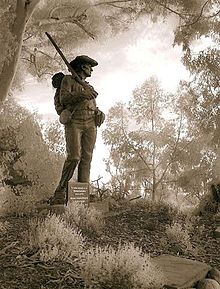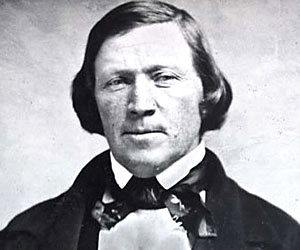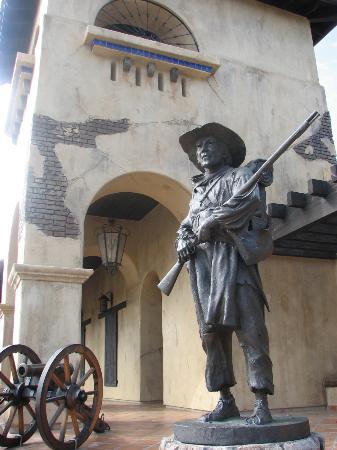The Mormon Battalion, a volunteer unit of between 534 and 559 Latter-day Saints men, served from July 1846 to July 1847 in the 1846 U.S. campaign against Mexico. It was the only religiously based unit in United States military history. The battalion made an arduous march of nearly 2,000 miles from Council Bluffs, Iowa, to San Diego, California, led by Mormon company officers under the command of United States Army officers.
Although the Mormon Battalion never engaged in an actual battle, it earned a rightful place in the history of the West. The march and the service rendered was instrumental in helping the U.S. secure much of the American Southwest to include new territory in several Western states. Of particular noteworthiness was the Gadsden Purchase of much of southern Arizona in 1853. The march also opened a southern wagon route to California, and veterans of the battalion played significant roles in the westward expansion of California, Utah, Arizona, and other parts of the West.
The Longest Historical Infantry March
 In 1846, the United States was actively engaged in the Mexican-American War. James K. Polk, then President of the United States, called for 500 to 1,000 Mormon volunteers to march to Fort Leavenworth (present-day Kansas) and then to California on a one-year U.S. Army enlistment. On Saturday, 18 July 1846, muster was held for the Mormon recruits, and on Monday, 20 July 1846, on the Little Pony River in Council Bluffs, Iowa, the Mormon Battalion began their trek, which would cover approximately 1,850 miles by the time they reached San Diego, California.
In 1846, the United States was actively engaged in the Mexican-American War. James K. Polk, then President of the United States, called for 500 to 1,000 Mormon volunteers to march to Fort Leavenworth (present-day Kansas) and then to California on a one-year U.S. Army enlistment. On Saturday, 18 July 1846, muster was held for the Mormon recruits, and on Monday, 20 July 1846, on the Little Pony River in Council Bluffs, Iowa, the Mormon Battalion began their trek, which would cover approximately 1,850 miles by the time they reached San Diego, California.
The battalion arrived at Fort Leavenworth (Kansas) on 1 August 1846, where they were outfitted with the necessary accoutrements, and received a military clothing allowance of forty-two dollars. As military uniforms were not required, many of the recruits sent their clothing allowances to their families who were back in the camps in Iowa. Members of the battalion honored their military assignment – some served for one to three years, while others served for nearly a decade.
A Call to Arms
Susan Easton Black, a professor of Church History and Doctrine at Brigham Young University in Provo, Utah, in her article about the Mormon Battalion in the Utah History Encyclopedia recounts the beginning days of the battalion:
In July 1846, under the authority of U.S. Army Captain James Allen and with the encouragement of Mormon leader Brigham Young, the Mormon Battalion was mustered in at Council Bluffs, Iowa Territory. The battalion was the direct result of Brigham Young’s correspondence on 26 January 1846 to Jesse C. Little, presiding elder over the New England and Middle States Mission. Young instructed Little to meet with national leaders in Washington, D.C., and to seek aid for the migrating Latter-day Saints, the majority of whom were then in the Iowa Territory. In response to Young’s letter, Little journeyed to Washington, arriving on 21 May 1846, just eight days after Congress had declared war on Mexico.
Little met with President James K. Polk on 5 June 1846 and urged him to aid migrating Mormon pioneers by employing them to fortify and defend the West. The president offered to aid the pioneers by permitting them to raise a battalion of five hundred men, who were to join Colonel Stephen W. Kearny, Commander of the Army of the West, and fight for the United States in the Mexican War. Little accepted this offer.
Colonel Kearny designated Captain James Allen, later promoted to Lieutenant Colonel, to raise five companies of volunteer soldiers from the able-bodied men between the ages of eighteen and forty-five in the Mormon encampments in Iowa. On 26 June 1846 Allen arrived at the encampment of Mt. Pisgah. He was treated with suspicion as many believed that the raising of a battalion was a plot to bring trouble to the migrating Saints.
Allen journeyed from Mt. Pisgah to Council Bluffs, where on 1 July 1846 he allayed Mormon fears by giving permission for the Saints to encamp on United States lands if the Mormons would raise the desired battalion. Brigham Young accepted this, recognizing that the enlistment of the battalion was the first time the government had stretched forth its arm to aid the Mormons.
On 16 July 1846 some 543 men enlisted in the Mormon Battalion. From among these men Brigham Young selected the commissioned officers; they included Jefferson Hunt, Captain of Company A; Jesse D. Hunter, Captain of Company B; James Brown, Captain of Company C; Nelson Higgins, Captain of Company D; and Daniel C. Davis, Captain of Company E. Among the most prominent non-Mormon military officers immediately associated with the battalion march were Lt. Col. James Allen, First Lt. Andrew Jackson Smith, Lt. Col. Philip St. George Cooke, and Dr. George Sanderson. Also accompanying the battalion were approximately thirty-three women, twenty of whom served as laundresses, and fifty-one children.
A Fulfilment of Prophecy
 Brigham Young, then President and Prophet of The Church of Jesus Christ of Latter-day Saints (often called the “Mormon” Church by the media and others), prophesied that not a single battalion member would be lost to hostile action. However, twenty members died due to the privations they suffered, with the first being Samuel Boly who died only twenty-eight miles from Council Bluffs. It is also reported that not a single shot was fired by the Mormon Battalion except at a herd of rampaging bulls. The battalion arrived in San Diego, California on Friday, 29 January 1847.
Brigham Young, then President and Prophet of The Church of Jesus Christ of Latter-day Saints (often called the “Mormon” Church by the media and others), prophesied that not a single battalion member would be lost to hostile action. However, twenty members died due to the privations they suffered, with the first being Samuel Boly who died only twenty-eight miles from Council Bluffs. It is also reported that not a single shot was fired by the Mormon Battalion except at a herd of rampaging bulls. The battalion arrived in San Diego, California on Friday, 29 January 1847.
Stanley B. Kimball, a professor of history at Southern Illinois University, in the conclusion to his article “The Mormon Battalion March, 1846–47” states:
The battalion filled its enlistment term with performed routine garrison duty in San Diego, San Louis Rey, and Los Angeles, until being discharged 16 July 1847. Some reenlisted for six months, but most made preparation for joining the pioneers in the Great Basin. They pushed north and picked up the Old California Trail east of San Francisco. Some decided to winter at Sutter’s Fort—and were present when gold was discovered in January 1848. Those who had gone on arrived in Salt Lake Valley 16 October 1847.
Historic Sites and Monuments
 There are several historic sites associated with the Mormon Battalion. These include the Mormon Battalion Memorial Visitor’s Center in San Diego, California; Fort Moore Pioneer Memorial in Los Angeles, California; and the Mormon Battalion Monument in Memory Grove, Salt Lake City, Utah. Monuments have also been built in New Mexico, Arizona, and Colorado, and trail markers have been placed on segments of the battalion route.
There are several historic sites associated with the Mormon Battalion. These include the Mormon Battalion Memorial Visitor’s Center in San Diego, California; Fort Moore Pioneer Memorial in Los Angeles, California; and the Mormon Battalion Monument in Memory Grove, Salt Lake City, Utah. Monuments have also been built in New Mexico, Arizona, and Colorado, and trail markers have been placed on segments of the battalion route.
The Mormon Battalion Historic Site of San Diego which was established in 2009 has been chosen to receive the California Historian of the Year Commercial Award which will be presented at the Conference of California Historical Societies on Saturday, 21 June 2014 in Los Angeles, California. The newly restored facility includes interactive displays, hands on activities, and entertaining presentations for people of all ages. Those who visit the site are also able to relive the trials and accomplishments of the Mormon Battalion through journals of members of the battalion.
About Keith L. Brown
Keith L. Brown is a convert to The Church of Jesus Christ of Latter-day Saints, having been born and raised Baptist. He was studying to be a Baptist minister at the time of his conversion to the LDS faith. He was baptized on 10 March 1998 in Reykjavik, Iceland while serving on active duty in the United States Navy in Keflavic, Iceland. He currently serves as the First Assistant to the High Priest Group for the Annapolis, Maryland Ward. He is a 30-year honorably retired United States Navy Veteran.

 Watch a video about the restoration of the gospel on lds.org
Watch a video about the restoration of the gospel on lds.org